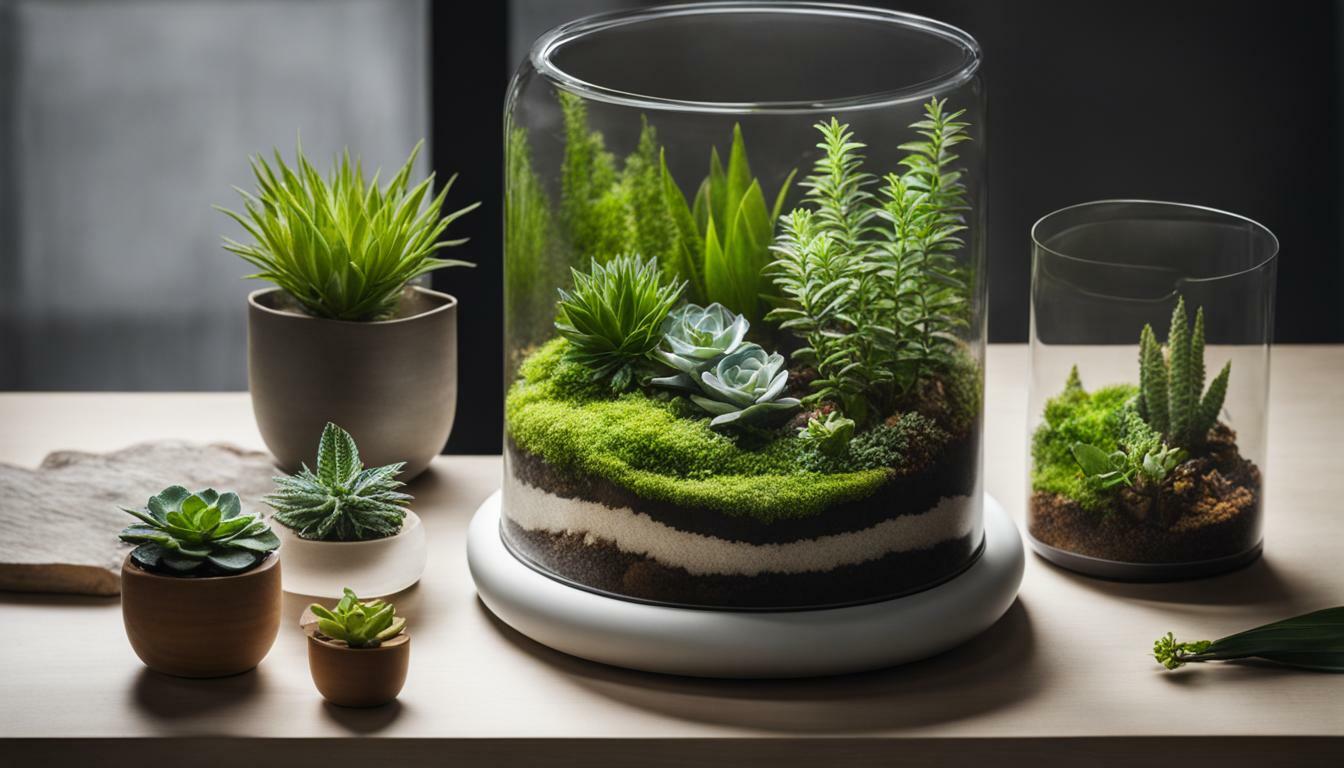Are you looking to create a beautiful and thriving indoor terrarium? Discover the ideal terrarium containers by shape for your indoor plants with our comprehensive guide. When choosing a terrarium container, considering the size and shape is crucial. A larger container provides ample space for your plants to grow while allowing for proper gas exchange. Containers with a uniform shape offer excellent support for your plants. Wide openings in terrarium containers make planting easier, eliminating the challenges posed by narrow openings.
Opting for glass terrarium containers is highly recommended due to their transparency and absence of toxic compounds that can leach into the terrarium environment. Mason jars, wardian cases, and geometric terrariums are popular options to consider. However, if you prefer plastic containers, be mindful of the type of plastic used and the possibility of chemical leaching.
When it comes to sourcing terrarium containers, you have various options. Homeware stores, Etsy, and Amazon offer a wide selection, while thrift stores and online marketplaces can provide unique finds.
To create an optimal terrarium environment, choose plants that thrive in humid conditions. Use a base layer of drainage consisting of coarse gravel and activated charcoal, followed by sheet moss and sterile potting mix. Carefully position your plants in the container and consider adding decorative elements such as bark, stones, and reindeer moss for visual appeal.
Proper care is essential for the health of your terrarium. Place it in bright but indirect sunlight, and water lightly every few weeks for open terrariums or every 4-6 months for closed terrariums. Regularly remove yellowing or damaged leaves, and make sure to periodically clean the terrarium container to maintain its beauty.
If you’re feeling creative, you can even create DIY terrarium containers and makeshift lids using materials such as saran wrap, cut-to-size perspex discs, or cork stoppers. This allows you to customize your terrarium to your liking while still maintaining an appropriate environment for your indoor plants.
Lastly, we provide troubleshooting tips to address common issues such as excessive moisture, fungal growth, or wilting plants. Enhance the visual appeal of your terrarium by adding unique elements like decorative bark, stones, and reindeer moss.
Key Takeaways:
- Choose terrarium containers based on their size and shape for optimal plant growth.
- Containers with wide openings make planting easier and more convenient.
- Glass terrarium containers are preferred over plastic ones due to their transparency and lack of toxic compounds.
- Consider sourcing terrarium containers from various locations, including homeware stores, online marketplaces, and thrift stores.
- Create an ideal terrarium environment by selecting plants suited for humid conditions and adding proper drainage layers.
Choosing the Right Size and Shape
When it comes to choosing terrarium containers, size and shape play a crucial role in the healthy growth of your indoor plants. The size of the container determines how much space the plants have to root and grow, while the shape of the container affects their overall support and aesthetic appeal. It’s important to consider these factors to create an optimal environment for your plants.
A larger terrarium container provides more room for your plants to spread their roots and establish a healthy growth pattern. This extra space allows for proper gas exchange and reduces the risk of overcrowding, which can lead to nutrient deficiencies or stunted growth. Additionally, a larger container provides more room for decorative elements like rocks, moss, or figurines, enhancing the overall visual appeal of your terrarium.
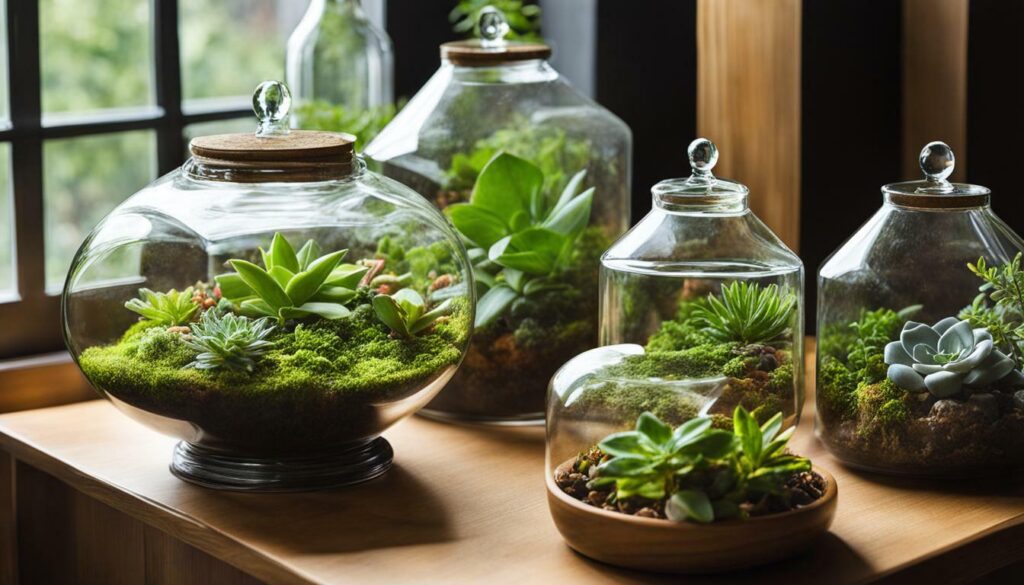
Uniformly shaped containers offer better plant support compared to irregularly shaped ones. Plant roots need stability to anchor themselves securely and absorb water and nutrients effectively. Containers with uniform shapes, like cylindrical or square ones, provide better structural support for your plants, preventing them from toppling or bending under their own weight.
To ensure ease of planting, choose terrarium containers with wide openings. Narrow openings can make it difficult to maneuver your hands and planting tools, making the planting process challenging and potentially damaging your plants. Containers with wide openings, on the other hand, allow for easy access, making it simpler to place your plants and arrange the decorative elements without causing any harm.
Containers with Wide Openings for Ease of Planting
Making the planting process a breeze, terrarium containers with wide openings offer convenience and accessibility for your indoor plants. When selecting terrarium containers, it’s important to consider the ease of planting and the ability to access the plants without difficulty. Containers with narrow openings can make it challenging to maneuver plants and arrange them properly. Additionally, narrow openings can cause damage to the plants or disturb the arrangement when attempting to water or care for them.
Avoid these potential issues by opting for terrarium containers with wide openings. These containers provide ample space for planting your indoor plants and allow for easy access during maintenance. Wide openings make it easier to position and adjust plants, ensuring proper placement for optimal growth. Whether you’re planting small succulents or delicate ferns, containers with wide openings offer the flexibility you need to create a beautiful and thriving terrarium.
To illustrate the benefits of wide openings, consider the following comparison:
| Narrow Opening | Wide Opening |
|---|---|
| Difficult to plant | Easy to plant |
| Limited access for maintenance | Convenient for maintenance |
| Restricted plant arrangement | Flexibility in plant arrangement |
By selecting terrarium containers with wide openings, you can streamline the planting process and ensure a hassle-free experience. The wide openings provide the accessibility and flexibility needed to create a visually stunning and healthy environment for your indoor plants.
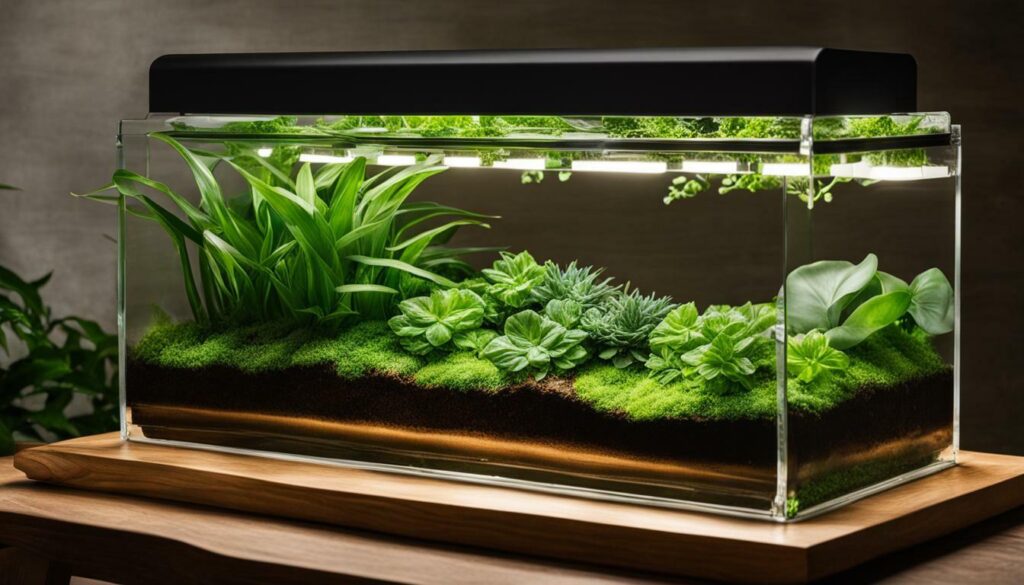
Glass terrarium containers offer numerous benefits compared to their plastic counterparts, making them the preferred choice for many indoor plant enthusiasts. The transparency of glass allows for an unobstructed view of the plants, creating a visually appealing display. Glass containers also do not leach toxic compounds into the terrarium environment, ensuring a safe and healthy space for the plants to thrive.
Another advantage of glass terrarium containers is their versatility. They come in various shapes and sizes, such as mason jars, wardian cases, and geometric terrariums, allowing plant lovers to find the perfect container that suits their aesthetic preferences. Glass containers also provide better insulation, maintaining a more stable environment for the plants and reducing the risk of temperature fluctuations.
Furthermore, the non-porous surface of glass makes it easier to clean and maintain compared to plastic. It does not retain odors or stains, providing a cleaner and more hygienic environment for the plants. Glass terrarium containers are also more durable and less prone to scratches, ensuring that they can be enjoyed for a long time.
In summary, glass terrarium containers offer a range of benefits, including their transparency, non-toxic nature, versatility, insulation properties, easy maintenance, and durability. Whether you’re a novice or an experienced indoor plant enthusiast, glass containers are an excellent choice for creating a beautiful and healthy environment for your terrarium.
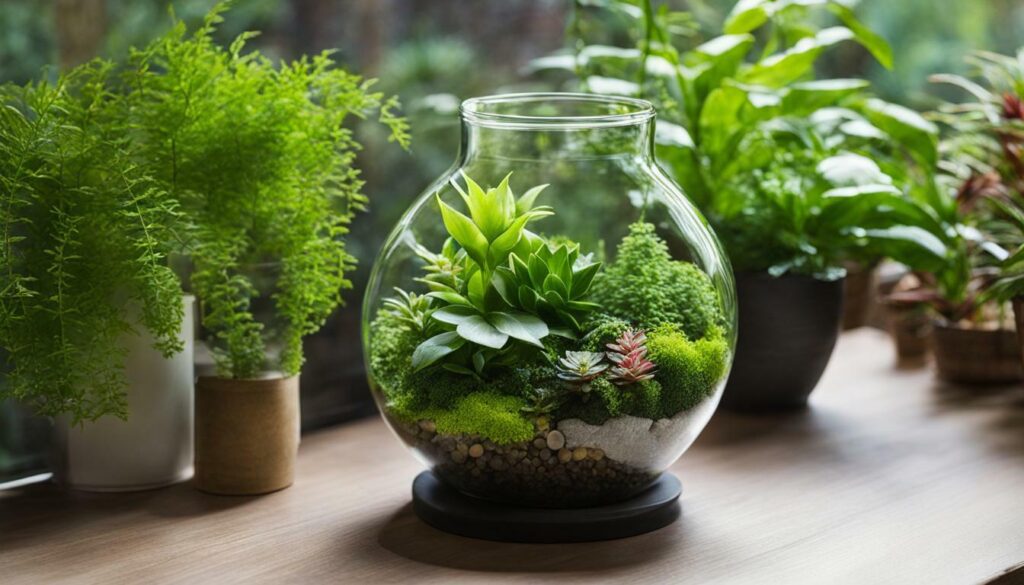
The table below provides a comparison between glass and plastic terrarium containers:
| Criteria | Glass Terrarium Containers | Plastic Terrarium Containers |
|---|---|---|
| Transparency | Transparent, allows an unobstructed view | Opaque or translucent, limits visibility |
| Toxicity | Non-toxic, does not leach harmful compounds | Potential for chemical leaching |
| Cleaning | Easy to clean, non-porous surface | May retain odors and stains |
| Durability | Durable, less prone to scratches | Prone to scratching and wear |
Considerations for Plastic Terrarium Containers
Plastic terrarium containers can also be suitable options, but it’s essential to consider certain factors to ensure the health of your indoor plants. When choosing a plastic container, look for ones that are made from food-grade, BPA-free plastic to minimize the risk of chemical leaching. Avoid containers that are made from brittle or low-quality plastics that may crack or deteriorate over time.
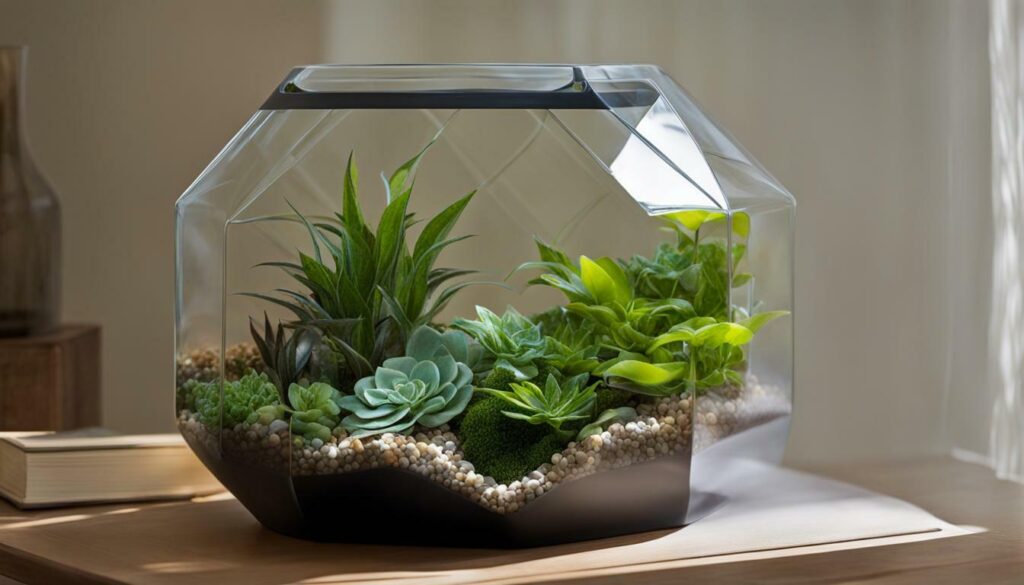
Additionally, consider the transparency of the plastic container. Transparent containers allow for better visibility and aesthetic appeal, allowing you to admire the beautiful foliage of your terrarium plants. However, if you prefer a more opaque or colored look, choose containers that still allow sufficient light to penetrate.
It is also important to ensure proper ventilation in plastic terrarium containers. Look for containers with small ventilation holes to allow for air circulation, especially in closed terrariums. Adequate airflow helps prevent the buildup of excess moisture, which can lead to fungal growth and root rot.
When purchasing plastic terrarium containers, be mindful of the size and shape. Opt for containers that provide enough space for your plants to grow and thrive. Containers with a wide base and stability are ideal for supporting taller or top-heavy plants. Remember to choose a container with no drainage holes and create a suitable drainage layer using coarse gravel and activated charcoal.
Table 5.1: Pros and Cons of Plastic Terrarium Containers
| Pros | Cons |
|---|---|
| Lightweight and easy to handle | Potential for chemical leaching |
| Less fragile and more durable than glass | May discolor or become brittle over time |
| Can come in various shapes and sizes | May not provide as clear of a view as glass containers |
| Affordable and readily available | May require additional ventilation holes |
When properly selected and maintained, plastic terrarium containers can provide a suitable and budget-friendly option for housing your indoor plants. Just ensure that you consider the material, transparency, ventilation, and size to create an optimal environment for your terrarium plants to thrive.
Where to Find Terrarium Containers
Looking for the perfect terrarium container? Check out these places where you can find a wide variety of options to suit your indoor plant needs.
1. Homeware stores: Visit your local homeware stores, such as garden centers or specialty stores that focus on indoor plant accessories. They often have a dedicated section for terrarium containers, where you can browse through a range of shapes, sizes, and materials.
2. Online platforms: Explore websites like Etsy and Amazon, which offer an extensive selection of terrarium containers. You can find unique designs crafted by independent artisans or choose from a wide range of commercial options. Online platforms also provide the convenience of easy browsing and doorstep delivery.
3. Thrift stores and online marketplaces: Don’t overlook the potential treasure trove of terrarium containers at thrift stores and online marketplaces like Facebook Marketplace or eBay. You might stumble upon vintage glass jars, decorative vases, or other unconventional containers that can add a touch of uniqueness to your indoor garden.
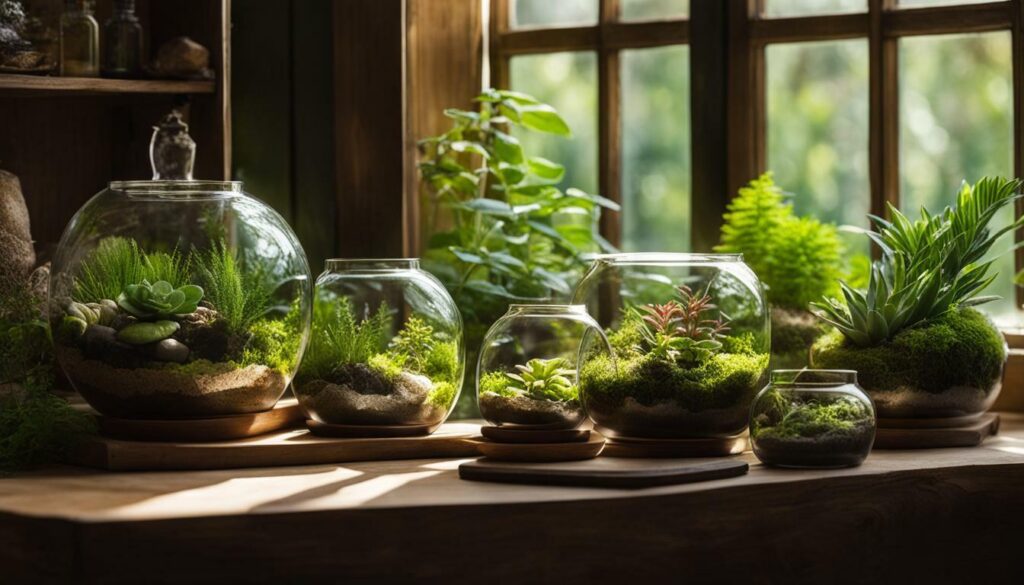
| Container Type | Material | Advantages | Disadvantages |
|---|---|---|---|
| Glass Terrariums | Glass | Transparent, no chemical leaching, aesthetic appeal | Breakable, heavy |
| Plastic Terrariums | Plastic | Lightweight, less breakable, affordable | Possible chemical leaching, less aesthetic appeal |
| DIY Containers | Various (upcycled materials) | Cost-effective, customizable, environmentally friendly | Limited material options, may require more effort |
When selecting your terrarium container, consider the type of material, the size, and shape that will best complement your indoor plants. Remember, different plants have different requirements, so choose a container that suits their needs. With a little creativity and careful consideration, you can find the perfect terrarium container to create a stunning, thriving indoor garden.
Creating an Optimal Terrarium Environment
To ensure the well-being of your indoor plants, follow these steps to create an optimal terrarium environment:
- Choose a container without drainage holes: Terrariums are designed to create a self-sustaining ecosystem, so it’s important to select a container that doesn’t allow water to drain out. This will help maintain the necessary humidity levels for your plants.
- Select tropical plants that thrive in humid environments: The key to a successful terrarium is choosing plants that can thrive in the moist conditions created inside. Some popular choices include ferns, mosses, and air plants.
- Add drainage layers: Start by adding a layer of coarse gravel at the bottom of the container. This will help prevent excess water from pooling around the roots and causing them to rot. Next, add a layer of activated charcoal to absorb any toxins and keep the terrarium smelling fresh.
- Use sheet moss and sterile potting mix: The base layer of your terrarium should consist of sheet moss, which acts as a barrier between the potting mix and the drainage layers. Use a sterile potting mix specifically formulated for indoor plants to provide the necessary nutrients without introducing pests or diseases.
Now that your terrarium is ready, it’s time to carefully place your chosen plants inside. Create a layout that not only looks visually appealing but also considers the growth habits and lighting needs of each plant. Once the plants are in place, you can decorate the terrarium with additional elements such as decorative bark, stones, and reindeer moss.
Remember to place your terrarium in a location with bright but indirect sunlight. Direct sunlight can cause the temperature inside the terrarium to rise, leading to overheating and damage to the plants. Water lightly every few weeks for open terrariums, and for closed terrariums, water sparingly every 4-6 months, as the enclosed environment will help retain moisture. Keep an eye out for any yellowing or damaged leaves and remove them promptly to maintain the health of your plants.
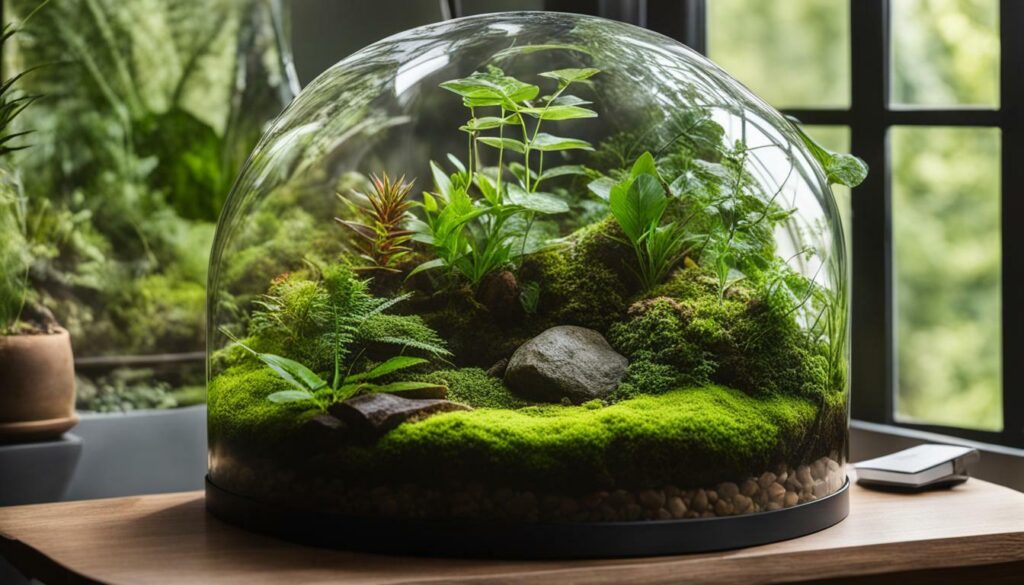
Periodically cleaning the glass or plastic of your terrarium container will help remove any dust or residue that may accumulate. A clean container not only enhances the visual appeal but also ensures that your plants can receive maximum light for photosynthesis.
Proper Care for Your Terrarium
Give your terrarium the love and care it deserves by following these essential tips for proper maintenance. Terrariums require specific attention to ensure the health and longevity of the plants inside. By establishing a regular care routine, you can create an optimal environment for your terrarium and enjoy its beauty for years to come.
- Lighting: Place your terrarium in an area with bright, indirect sunlight. This will provide the plants with the necessary light for photosynthesis while preventing them from getting sunburned. Keep in mind that each terrarium has different lighting requirements based on the types of plants it contains. Consulting a plant guide or speaking with a horticulturist can help you determine the best lighting conditions for your specific terrarium.
- Watering: When it comes to watering your terrarium, it’s important to find the right balance. Open terrariums tend to dry out more quickly than closed terrariums due to increased airflow. Water open terrariums lightly every few weeks, ensuring the soil is moist but not waterlogged. Closed terrariums, on the other hand, create a self-sustaining ecosystem and require less frequent watering. Check the moisture level by touching the soil, and water only when it feels dry. Overwatering can lead to root rot, so it’s better to err on the side of underwatering.
- Leaf Maintenance: Regularly inspect your terrarium for any yellowing or damaged leaves. These leaves can indicate stress or disease in the plants and should be removed promptly to maintain the overall health of the terrarium. Use sharp scissors or pruning shears to carefully trim away any affected foliage. This will encourage new growth and help keep your terrarium looking its best.
- Cleaning: Over time, dust and debris may accumulate on the glass or plastic of your terrarium container, affecting its appearance and the amount of light reaching the plants. Periodically clean the container with a soft cloth or sponge and mild, non-toxic soap. Avoid using harsh chemicals or abrasive materials that may damage the container. By keeping your terrarium clean, you’ll ensure optimal light transmission and maintain a visually appealing display.
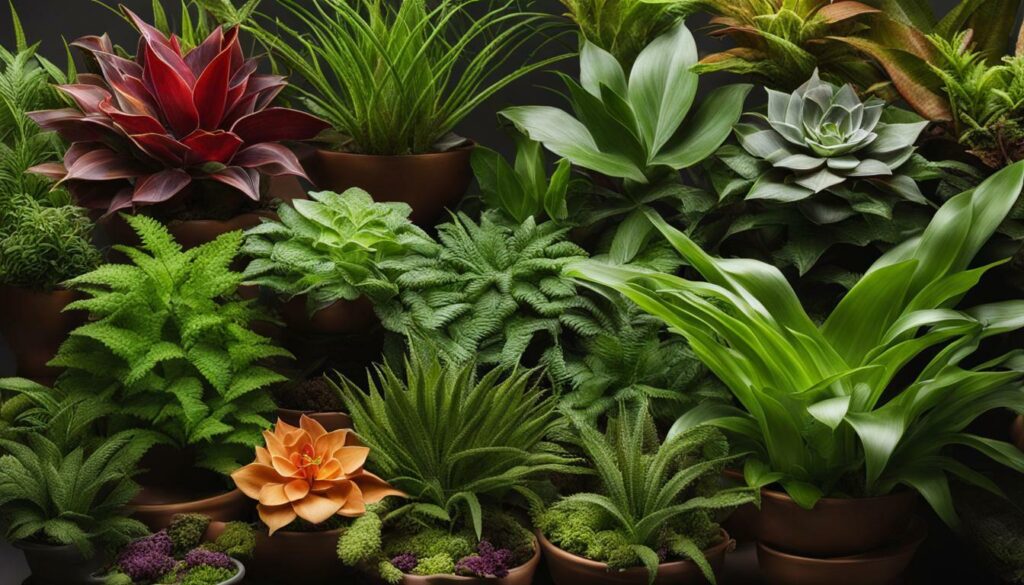
With proper care, your terrarium will become a stunning centerpiece in your home or office, bringing the beauty of nature indoors. Remember to regularly assess the lighting, water in moderation, tend to the leaves, and keep the container clean. By following these tips, your terrarium will thrive, and you’ll enjoy a little piece of greenery year-round.
DIY Terrarium Containers and Lid Options
Get creative and explore DIY options for terrarium containers and lids to customize your indoor plant display. Not only will this allow you to add a personal touch to your terrarium, but it can also be a cost-effective solution. You can repurpose everyday objects or create unique containers from scratch to suit your style and plant needs.
When it comes to DIY terrarium containers, the possibilities are endless. Consider using glass jars, such as mason jars or old apothecary bottles, to create a vintage-inspired terrarium. These containers are readily available and provide a clear view of your plants. Simply clean them thoroughly and make sure they have no residual odors before repurposing them for your terrarium.
If you prefer a modern look, geometric terrariums offer a sleek and contemporary aesthetic. These can be made using glass panels and adhesive to create the desired shape. Experiment with different angles and dimensions to showcase your indoor plants in a unique way.
When it comes to creating homemade lids for your terrarium, you have several options. Saran wrap is a simple and effective choice for open terrariums. It allows for air circulation while retaining moisture. For closed terrariums, cut-to-size perspex discs or cork stoppers can be used as lids. These materials provide a snug fit and help create a controlled environment for your plants.
| Type of DIY Container | Benefits |
|---|---|
| Glass Jars | Clear view of plants, vintage aesthetic |
| Geometric Terrariums | Modern look, customizable shapes |
| Saran Wrap | Air circulation, moisture retention for open terrariums |
| Perspex Discs | Snug fit, controlled environment for closed terrariums |
| Cork Stoppers | Secure lid option, natural and sustainable material |
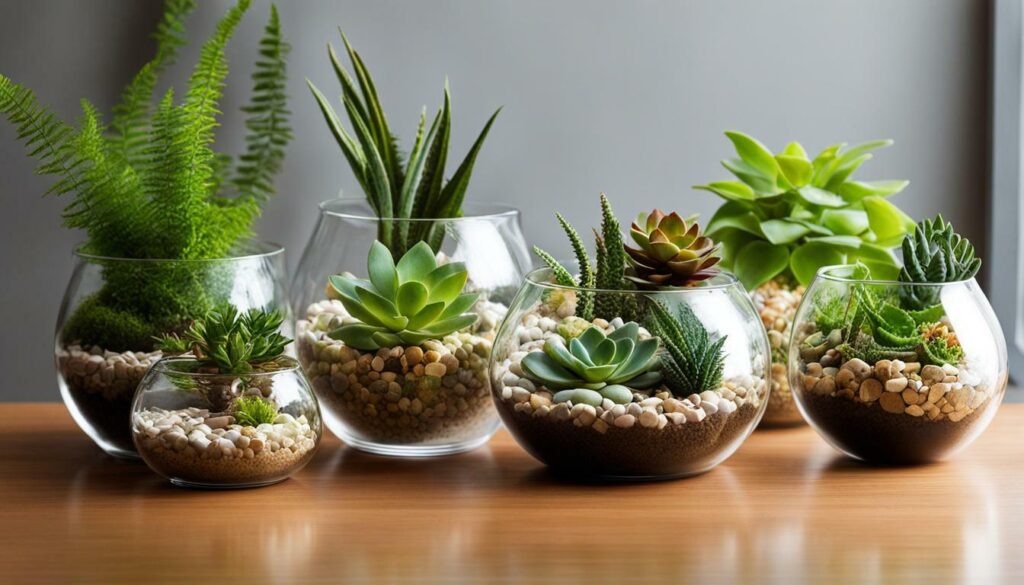
“Creating your own DIY terrarium containers and lids not only allows you to showcase your creativity but also provides a unique home for your indoor plants.”
Remember, when making your own DIY terrarium containers and lids, ensure they are clean and sterile to prevent any potential harm to your plants. Additionally, consider the size and shape of your containers to accommodate the specific needs and growth patterns of your indoor plants. With a little imagination and resourcefulness, you can create stunning and personalized terrariums that will be the centerpiece of any room.
Tips for Troubleshooting and Enhancement
Keep your terrarium thriving and visually stunning with these troubleshooting tips and suggestions for enhancing its overall aesthetic.
If you notice excessive moisture in your terrarium, it may be a sign of overwatering. To remedy this, remove the lid for a few days to allow the excess moisture to evaporate. If there are still issues, consider adding extra drainage layers of coarse gravel or adjusting the watering frequency. It’s important to strike a balance between keeping the terrarium moist without causing waterlogged conditions.
Fungal growth can sometimes occur in terrariums, especially in closed environments. To combat this, increase airflow by removing the lid for a short period each day. Additionally, ensure that the terrarium receives indirect sunlight as excessive heat and humidity can contribute to fungal growth. If fungal growth persists, it may be necessary to remove affected plants and clean the container thoroughly before replanting.
To enhance the visual appeal of your terrarium, consider incorporating unique elements. Decorative bark, stones, and reindeer moss can add texture and depth to the arrangement. These decorative elements not only elevate the overall aesthetic but also create a more natural and visually pleasing display. Experiment with different arrangements and combinations to find the look that best complements your indoor space.
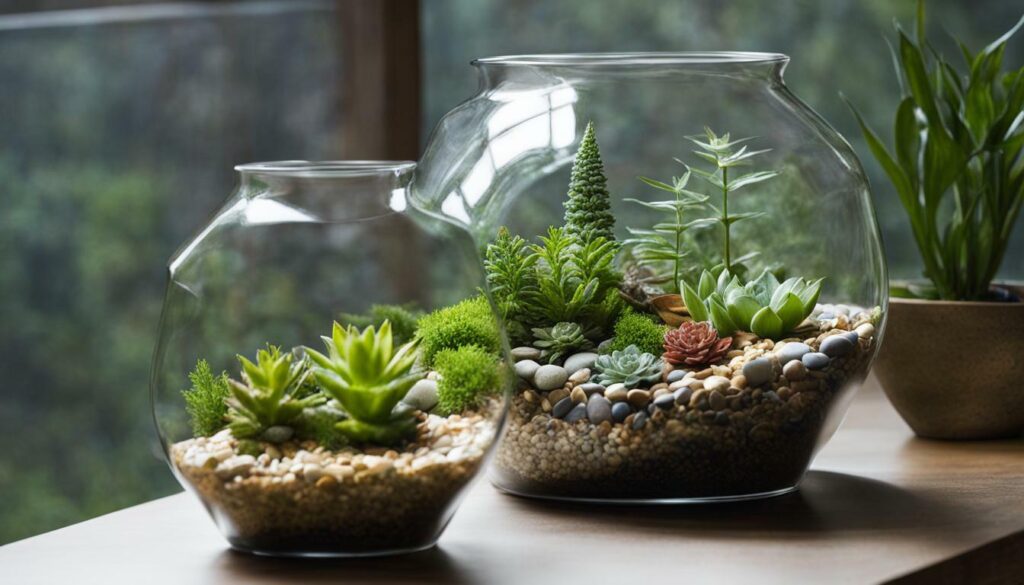
Remember, troubleshooting and enhancing your terrarium is an ongoing process. Regularly inspect your terrarium for any signs of plant stress, such as wilting or yellowing leaves. Remove any damaged or dying foliage promptly to maintain the overall health of the terrarium. Additionally, periodically clean the glass or plastic of the container to keep it looking its best.
By following these tips and suggestions, you can create a thriving and visually stunning terrarium that brings a touch of nature to your indoor space.
Conclusion
Choose the right terrarium containers by shape to create a stunning indoor plant display while ensuring the well-being of your indoor plants. When selecting a container, consider both the size and shape. Opt for larger containers that provide ample space for your plants to grow and allow for proper gas exchange. Containers with a uniform shape offer optimal support for your plants. Additionally, containers with wide openings make the planting process easier, avoiding the challenges of narrow openings.
Glass terrarium containers are preferred over plastic options due to their transparency and absence of toxic compounds leaching into the terrarium environment. Mason jars, wardian cases, and geometric terrariums are popular choices for glass containers. However, if using plastic containers, be mindful of the type of plastic used and the potential for chemical leaching.
When looking to acquire terrarium containers, a wide range of options is available. Homeware stores, online platforms such as Etsy and Amazon, as well as thrift stores and online marketplaces, are excellent sources. With your chosen container, create an optimal terrarium environment by selecting tropical plants suited for humid conditions. Add drainage layers of coarse gravel and activated charcoal to prevent root rot, and use sheet moss and sterile potting mix as base layers. Carefully place the plants in the container and enhance the visual appeal by including decorative elements like bark, stones, and reindeer moss.
Proper care is essential for maintaining healthy terrariums. Place the terrarium in bright but indirect sunlight, ensuring it receives adequate light. Water the plants lightly every few weeks for open terrariums and every 4-6 months for closed terrariums. Regularly remove yellowing or damaged leaves to maintain the plants’ overall health. Additionally, periodic cleaning of the terrarium container, whether glass or plastic, helps to keep it looking pristine, allowing you to fully enjoy your indoor plant display.
What Shape of Terrarium Container Works Best for Different Indoor Plants?
When choosing a terrarium container, consider the specific needs of your indoor plants. For succulents and cacti, a wide, shallow container is best. For ferns and mosses, opt for a taller, narrow container. Whether you choose glass, ceramic, or plastic, the right container can provide a beautiful green touch for home.
FAQ
What should I consider when choosing a terrarium container?
When choosing a terrarium container, consider the size and shape. It is recommended to go for a larger container to give the plants more space and allow for proper gas exchange. Containers with a uniform shape are ideal for proper plant support.
Are containers with narrow openings suitable for planting?
Containers with narrow openings can be challenging to plant. It’s best to go for containers with wide openings for ease of planting.
What materials are recommended for terrarium containers?
Glass containers are preferred over plastic as they are transparent and do not leach toxic compounds into the terrarium environment. Popular types of glass terrarium containers include mason jars, wardian cases, and geometric terrariums. Plastic containers can also be used, but it’s important to consider the type of plastic used and the possibility of chemical leaching.
Where can I find terrarium containers?
Terrarium containers can be bought from a variety of places such as homeware stores, Etsy, and Amazon. They can also be sourced from thrift stores and online marketplaces.
How do I create an optimal terrarium environment?
Select a container with no drainage holes and choose tropical plants that thrive in humid environments. Add drainage layers of coarse gravel and activated charcoal to prevent rotting of plant roots. Use sheet moss and sterile potting mix for the base layer and carefully place the plants in the container. Decorate with additional elements such as bark, stones, and reindeer moss.
How do I care for my terrarium?
Place the terrarium in bright but indirect sunlight and water lightly every few weeks for open terrariums and every 4-6 months for closed terrariums. Remove yellowing or damaged leaves and periodically clean the glass or plastic of the terrarium container.
Can I create my own DIY terrarium containers and lids?
Yes, you can create makeshift lids using saran wrap and cut-to-size perspex discs or cork stoppers. Just make sure to maintain an appropriate environment for indoor plants.
What are some troubleshooting tips for terrariums?
If you’re facing issues like excessive moisture, fungal growth, or wilting plants, check the watering frequency and ensure proper ventilation. Adjust the environmental conditions as needed.
How can I enhance the visual appeal of my terrarium?
You can enhance your terrarium by adding unique elements like decorative bark, stones, and reindeer moss. These elements can elevate the overall aesthetic of your terrarium.

